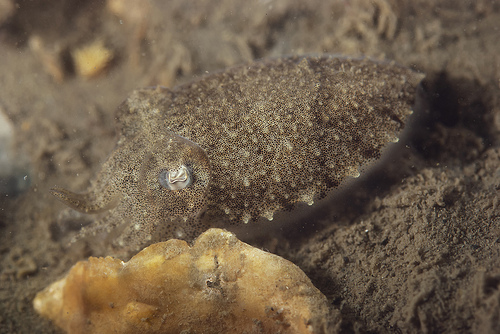Habitat
CONCEALMENT
The cuttlefish is an expert at concealment, meaning it has the
ability to change color in an instant to blend in with its
surrounding environment (Kings of Camouflage 2011). Camouflage alone
allows Sepia officinalis to be versatile in the habitat it
chooses to live in. However, diverse coral reefs in rather shallow
areas of marine environments are proven to be their geographic
commonplace in the world (Perez-Losada et al. 1999). An experiment
done in the Morhiban Bay by French scientists revealed through
trawling that young cuttlefish are much more active when water
temperatures are at the highest. In this region, it happens to be
July through August (Wang et al. 2003). In addition, a
cuttlefish uses camouflage as its main survival tactic. It can be
used for protection from
predators or hiding from
other threats. Sandy bottoms are the perfect environment for
cuttlefish to rest because it prevents them from being seen
easily by other passing creatures (Wang et al. 2003).
SEASONAL LOCATIONS
This species
inhabits
a wide range of depths in temperate marine regions. More specifically, they are
described as a shallow
water cephalopod, spending most of their time in sandy and muddy
areas on the sea floor (Animal Diversity Web 2011). Depending on
water temperatures, this depth that they’re living at can change
dramatically. For the fall and winter months, they dive down to
anywhere from 100-200m and stay there until there is a significant
increase in temperature, signaling the start of spring (Onsoy &
Salman 2003). These sandy
bottoms and shallow coral reefs in which they are located, are also
home to many fish, shrimp and other crustaceans that cuttlefish prey
on for food. However, there are more than just these smaller marine
organisms living among them. Sharks, dolphins and larger fish are
always roaming around these areas and often times pick out a
cuttlefish as their next potential meal (Wang et al. 2003).
GEOGRAPHY
Often called
the ‘English Cuttlefish’, Sepia officinalis inhabits a wide range
covering the eastern North Atlantic, the English Channel, and all the
way into the Mediterranean Sea (Kings of Camouflage 2011). In recent
years, however, populations have been discovered all along the
coasts of Africa. This strongly suggests that for some reason,
whether it be climate, genetics, or another cause, something is
affecting the species as a whole (Kings of Camouflage 2011).
Now that you know a little bit more about WHERE this organism lives, visit the form and function page to learn about HOW this organism lives.
![By Parent Géry (Own work) [Public domain], via Wikimedia Commons](travelportal/images/newheader.jpg)

